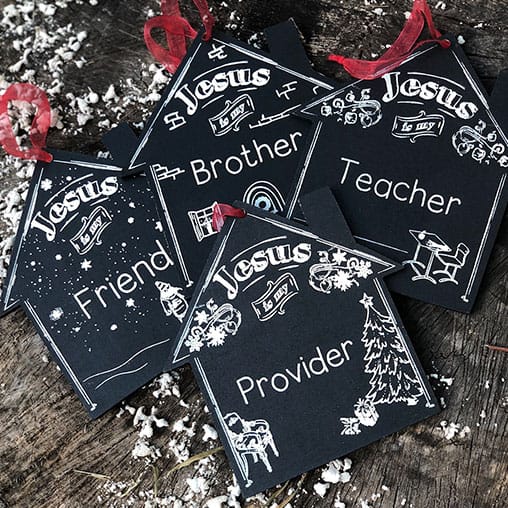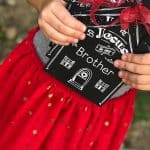
The Beginning of Something Good
Dennis and Barbara Rainey recall the events that led to Barbara's inspirational product line called Ever Thine Home. They share how the idea for Ever Thine Home began to germinate at a planning retreat. Now Barbara reveals her new line of Christmas ornaments, the family names of Jesus.
Show Notes
About the Guest
-
Dennis and Barbara Rainey recall the events that led to Barbara's inspirational product line called Ever Thine Home. They share how the idea for Ever Thine Home began to germinate at a planning retreat. Now Barbara reveals her new line of Christmas ornaments, the family names of Jesus.
-

Dennis and Barbara Rainey
Dennis and Barbara Rainey cofounded FamilyLife®, a ministry of Cru®. Their 43+ years of leadership enabled FamilyLife to grow into a dynamic and vital ministry in more than 109 countries. Together they have spoken at over 150 Weekend to Remember® marriage getaways and authored or co-authored more than 35 books, including best-selling Moments Together for Couples, Staying Close, A Symphony in the Dark, and Barbara’s most recent, Letters to My Daughters: The Art of Being a Wife...more
Dennis and Barbara Rainey recall the events that led to Barbara’s inspirational product line called Ever Thine Home. They share how the idea for Ever Thine Home began to germinate at a planning retreat.
The Beginning of Something Good
Bob: When Barbara Rainey had six kids still at home, she always found herself frustrated during the holiday season that there was no easy way to keep the focus where it belonged.
Barbara: I wanted to be able to talk to my kids about it, and I didn’t know how to talk to my kids about it other than reading a few storybooks that we had. I wanted to be able to interact with them. I wanted to be able to, for instance, have ornaments on our tree that were about Jesus—I didn’t want just snowmen, and reindeer, and Santas, and all of those things. I wanted Christmas to be about Jesus; Easter to be about Jesus; Thanksgiving to be about giving thanks and gratitude, because the whole Bible is about being thankful and being grateful.
Bob: This is FamilyLife Today for Monday, November 26th. Our host is Dennis Rainey, and I’m Bob Lepine. So as we enter into the Christmas season, are you ready to have conversations with your kids about the spiritual importance of this holiday?
1:00
We want to help you do that today. Stay with us.
And welcome to FamilyLife Today. Thanks for joining us.
Dennis: Bob, have you ever had a good story ruined by an eyewitness? [Laughter]
Barbara: I think he probably has, because he’s probably had you ruin his story—and vice versa. [Laughter]
Bob: Ruined a number of them! [Laughter]
Barbara: Vice versa; right?
Dennis: Bob has corrected me many times but not as many as my wife—my lovely wife, who I love and appreciate—but it’s like, “There you have it—another great illustration ruined by an eyewitness!”
Bob: I remember the first time both of us heard anybody say that—
Dennis: Yes.
Bob: —it was our friend, Howard Hendricks.
Barbara: Howard Hendricks.
Bob: He was telling some story about going fishing with you.
Dennis: Right; he said he only caught one. I just stopped him in the middle of his message—
Bob: He’s talking to a couple hundred people; yes.
Dennis: Three or four hundred people—and I said: “That isn’t right, Prof! You caught two!” [Laughter]
2:00
He stopped [imitating Howard’s voice]: “Well, there you have it. Another great illustration ruined by an eyewitness.” The place busted into laughter; so yes.
Anyway, this—what we’re talking about today is really—we just have different perceptions of reality—how it got started. [Laughter] We were empty-nesters. Barbara and I—who joins us on the broadcast. We haven’t formally—
Bob: —introduced you.
Barbara: I haven’t been, but I’ve made my voice known. [Laughter] So anyway,—
Dennis: Yes; you have.
Barbara: —here I am.
Bob: Your presence is noted. [Laughter]
Dennis: We went about a hundred miles north of here, and we had a four-day planning weekend.
Bob: This was a getaway for the two of you?
Barbara: Yes; it was.
Dennis: After the kids had left—empty-nest recalibration. My goal in that time was to get a couple of days for her—and her horizons, and her future, and maximize who she is and who she was—and a couple of days for me so I’d kind of be thinking about where I was headed too.
3:00
As I like to say, we really never got to talk about me—we did talk some about what I was going to do on the horizon. Barbara has corrected me, over the years, on multiple occasions—she’s said, “You said that we didn’t talk about you at all, and we did.” [Laughter] The reality is—
Barbara: Well, it makes a much better story; so, for a long time, I didn’t correct you.
Bob: Was it 50/50?
Barbara: I didn’t—no; I don’t think it was.
Bob: Was it 70/30? How much time did Dennis get in this planning retreat?
Dennis: Yes?—how about that, Barbara?
Barbara: I guess—I guess maybe it was closer to 50/50.
Dennis: Really?!
Barbara: Yes; so I think it was—
Dennis: Oh my!
Barbara: —because we had these poster boards that we—and for years—
Dennis: Oh my! Then, I’ve been lying all these years; huh?
Barbara: For years, I had the poster boards—where we wrote down things that he wanted to write or speak on or do, and things that we wanted to do together, and things that I wanted to do. I had those poster boards for a long time.
Bob: Yes.
Barbara: I should have kept them for evidence. I got rid of them one day when I was purging all the junk, so I don’t have any proof anymore; but my memory tells that me it was closer to 50/50.
4:00
Bob: And your recollection is not a 50/50?
Dennis: No; but you know what? Barbara’s right. [Laughter] Forty-six years of marriage—
Bob: Yes.
Dennis: —has taught me: “You know, you are right, Sweetheart.”
Bob: For those of you listening to FamilyLife Today, this is an important marriage principle to keep—
Dennis: Yes; it is.
Bob: —in mind that Dennis has just illustrated.
Dennis: There are two important principles here. Number one is defer to your spouse if at all possible. [Laughter] Number two—to the men: You are responsible to nourish and cherish, which means you are to cause your wife to grow spiritually—to nourish that and cherish her—make her feel valued. A part of that, I think, is helping her, as you begin to release your arrows into adulthood—is helping her understand: “What’s her calling? What’s her mission beyond the nest?” because when the nest empties out, you’ve got to have a purpose—you have to have a mission.
Bob: This planning retreat that you took had that in mind. You were wanting to figure out: “How can I help you thrive in this next season / this next chapter of life?”
5:00
That really set a course for the two of you; didn’t it?
Barbara: Yes; it really did. It wasn’t that that weekend—we made all our decisions, and they were final once and forevermore. It was more—it was the beginning of a long conversation that went on for the next, probably, ten or fifteen years—where we talked about what we wanted to do, and what we wanted to become, and what gifts and talents that we both felt like we had that hadn’t had the opportunity to be developed and to grow in the previous season of our life. Now, in this new season, where we had more margin, we might be able to actually develop some of those and explore some new things together. So it wasn’t a one weekend and we had it all solved. It was the beginning of a long conversation.
Dennis: But it was something that I felt like germinated.
Barbara: It did.
Dennis: I felt like we created the atmosphere of a planning getaway, and Barbara shared her heart.
6:00
She’s a very gifted woman—she could do a lot of things. She’s extremely gifted at Bible study—and seeing the needs in people and delivering the Word in practical ways to help them and their families grow spiritual—but secondly, she’s an artist. That came out clearly—we kind of merged those two together. What was germinated was what has been called, now, Ever Thine Home International®.
Barbara: That’s right. About seven years ago, I started dabbling in creating a few things that I always wished I had; because this whole thing began when we were raising kids. I was looking for ways to help my children understand why Jesus came at Christmas: “Why did He have to be born? Why did He choose to be born? Why did He come?” Then, again, at Easter, “Why did Jesus choose to die on the cross? What did that mean? How do I communicate these huge eternal incomprehensible truths to my children?”
7:00
Bob: These are the cornerstones of the gospel.
Barbara: Absolutely!
Bob: Yes.
Barbara: I wanted to be able to talk to my kids about it, and I didn’t know how to talk to my kids about it other than reading a few storybooks that we had. I wanted more than that—I wanted more than just a few stories we read at bedtime. I wanted to be able to interact with them. I wanted to be able to, for instance, have ornaments on our tree that were about Jesus—I didn’t want just snowmen, and reindeer, and Santas, and all of those things. I wanted Christmas to be about Jesus; Easter to be about Jesus; Thanksgiving to be about giving thanks and gratitude, because the whole Bible is about being thankful and being grateful.
Seven years ago, I began to dabble in designing and creating some expressions of those desires that I had when I was a mom. My first set of ornaments we debuted at Christmas in 2012 called “His Christmas Names.” They are the names of Jesus from the Book of Isaiah, the Book of Matthew, and the Book of Luke.
8:00
People responded way more than we ever dreamed that they would. It wasn’t just a: “Oh, this is nice.” It was “We sold them all out”-kind of response, which let me know that I wasn’t the only mom on the planet that wanted to have something beautiful that was also Christ-focused at Christmas.
Since then, we’ve created a bunch of Christmas ornaments. We’ve created a bunch of things for Easter to help families focus on the cross, and on the blood of Christ, and on all of the things that make Easter what it is for our redemption. We’ve got things for Thanksgiving, and we even got some things for throughout the year to help families focus on what is eternal and do it at home.
Bob: You said beautiful and Christ-focused. These are discipleship tools you’ve been creating.
Barbara: Yes; they are—not just something to hang on the wall. That’s a part of what I’ve been really passionate about—is I don’t want to just make something beautiful, or cute, or whatever might be in style to hang on the wall that hints at something that might have spiritual meaning.
9:00
I want what I create to have something that goes with it—where you can read a story to your kids that talks about the name, Prince of Peace, and why Jesus is our Prince of Peace; and that talks about the name, Savior, and why Jesus came to be a savior. He came and was born in a manger to die. We don’t talk about His death at Christmas—but they’re inseparable—we have to talk about them both. It is a discipleship emphasis in all that I’ve done over these last seven years.
Bob: And at Christmas, you’ve gone on to create more than two dozen ornaments now; right?
Barbara: Yes; I don’t know what the total is, but we—
Dennis: I think it’s over 30 now.
Bob: Is that right?
Dennis: Yes.
Barbara: We have seven sets. The first three were sets of seven, so we have 21 right off the bat. Then, we’ve got some additional sets; so it’s pushing 30.
Bob: So, is your tree at home—does it have any Santas or reindeer left?
Barbara: No.
Dennis: No.
10:00
Barbara: I don’t put Santas, or reindeer, snowmen, or sleighs, or any of those things on my tree anymore.
Dennis: Well, the cool thing is—I was reviewing a number of emails we’ve received over the years around what Barbara’s created. One of them came from Judy Douglass, who is the wife of the President and CEO of, formerly, Campus Crusade for Christ®—now Cru®.
Barbara: Cru.
Dennis: She wrote Barbara to tell her—she said, “The tree at headquarters in Orlando”—which I would imagine would be a sizeable tree—“is now just the names of Christ”—all done by Barbara and Ever Thine Home—because she said, “They’re beautiful, but they also have a message with them.”
Bob: They make a statement.
Dennis: They do. And I love what Theresa says—Theresa lives in Boulder; she raised four daughters—she said, “They’re not only beautiful, but they are engaging.” I think—
Barbara: That’s a good word.
Dennis: —that’s important, Bob; because I think, as parents, we have to find a way to get our kids’ attention away from these little screens and engage them in a real relationship with you, as a parent; but pass on truth as you have the relationship in place.
11:00
Bob: Yes; Barbara, you said you’d always wished you’d had these when your kids were young. You actually started creating them after you were an empty-nester.
Barbara: Yes.
Bob: But you’ve now seen younger moms, who are grabbing onto these and doing with them what you wished you could have done when your kids were little.
Barbara: Exactly; exactly. I didn’t have the bandwidth when I was raising our kids. I wanted to—I tried to do a few things—but I just had too many interruptions, which most moms do. To be able to focus on creating them and, also, writing stories that you could read to your kids—I just couldn’t do it when I was raising kids.
It has been fun to watch these young moms do it, because we’ve seen so many families use these ornaments. They read the stories out loud to their kids before Christmas in the month of December. We’ve seen kids come to Christ; because it opened the door to a conversation about why each person needs to, individually, receive Jesus as Savior.
12:00
Children have come to know Christ because of decorating the Christmas tree—well, it seems to me—that’s what it should be about.
Bob: We’ve got a link on our website at FamilyLifeToday.com if listeners want to go and see all of these ornaments—all 30-plus—whatever the number is that you’ve created. They can go and click on the link and get an idea of how they can utilize the names of Christ as a part of their decoration but, also, as a part of their discipleship during the Christmas season.
Dennis: And this year’s names—I think it’s fun because she has “His Christmas Names,” “His Savior Names,” “His Eternal Names,”—
Barbara: —“Royal Names.”
Dennis: —yes; “Royal Names.”
Barbara: —“Advent Names.”
Dennis: There you go.
Barbara: And “His Name Among the Nations,” which is “Jesus” in five different languages—so ornaments that make your tree international.
Dennis: And this year’s?
Barbara: And this year—it’s really fun to be doing this program on FamilyLife Today about this year’s ornaments; because this year’s ornaments are called “His Family Names.”
13:00
When you think about the Bible, what was one of the very first things—and you’ve said this, Dennis, a million times on the broadcast—what’s one of the first things that God created in the first few chapters of Genesis? He created marriage—He called Adam and Eve to get married; and He said: “…reproduce children,”—create a family. At the end of the Bible, it talks about the family.
When Jesus came to earth, he came to show us the Father. That is very clear in the Book of John—Jesus said, “I came to show the Father,”—so we know of God as our Father; and Jesus told His disciples that He was their brother. He also talked about being our friend, and He talked about being our provider. Jesus is also our teacher—that’s really clear in the New Testament too.
Those are relationship names that we’re all very comfortable with, as people—we know families. Moms and dads teach—it says in Proverbs—
14:00
—it commands mothers and fathers to teach your children. Parents are providers; parents are also teachers. Your children—you want them to be friends with each other. So, the names of the ornaments this year are all family-centric. They are names that we associate with family—with all families—so to understand that Jesus initiated family in the first place.
When He was born, He was born into a family. He had a mother and a father, and He had siblings. He—when He went to heaven, He invited us to be a part of His forever family. It’s a relationship—the Trinity is a relationship, and we’re invited to participate in that and to be a part of God’s family.
This year’s ornaments are cute little chalkboard houses. They say: “Jesus is my friend,” “…my provider,” “…my brother,” and “…my teacher.”
Dennis: And call me dense or thick—even though I’m married to this creative, beautiful follower of Christ—
15:00
—I really had never thought about: “All these are relational.” Now, a family is about relationships; but you just articulated it and clarified it. I think that’s important, because a family is where a child first finds out who God is.
Barbara: That’s right.
Dennis: Now, think about it. Reflect on your own upbringing. Even if you didn’t have godly parents, you learned a lot about who God is from imperfect parents. Our first concept of our heavenly Father comes from our earthly fathers. I think what we have here is a great vehicle to start talking to our children about the names of Christ, very practically, within the family setting.
As I’ve really thought about what Barbara has done, I’ve been amazed at how many different names Christ has in the Bible. How many did you tell me that you found?
Barbara: Well, some scholars say as many as 300.
16:00
That’s just more than we can grasp or understand. Even if we saw a list of them, it’s just mind-boggling.
To have the names of Jesus—the ones that are the most common / the ones that we know the best—to have them in a visual form that you can put on your Christmas tree or even keep out all year—I’m recommending to families that they let their kids hang their favorite one of these little family names in their room all year long to remind them, throughout the school year, that: “Jesus is my friend”; “He’s my teacher”; “He’s my brother”; because then, that makes us feel the warmth and the love that God has for us when we think about Him in these relational terms that we understand.
Taking the names of Jesus—and making them practical, making them visual, and designing them in such a way that it reflects a little bit of what that name is all about—I think that helps us, as people in our finite limitedness, be able to embrace a little bit more of the incomprehensible God.
17:00
Bob: And you provide guidance for us. Along with the ornaments—it’s not just “Jesus is my friend,”—but—“Here are some thoughts on how we can meditate on that idea.”
Barbara: Right.
Bob: Really, when you take a concept like “Jesus is my friend,” and you stop and you go: “Okay; so what does that mean?—the fact that I’m a friend of God / that God is my friend. How am I to understand that? How does that change the way I relate to Jesus—the way I relate to God?” That’s the kind of meditation you want us to be having, not just during the holiday season, but all-year long.
Barbara: Well, and one of the things that I’ve said, for years, when I speak to women is that moms need to be theologians; because moms are often the first person that a child asks a question about God—they’ll say: “Mommy, why can’t I touch God?” or “Why can’t I talk to God?” or whatever. Kids are going to ask mommy questions about God. Understanding the names and teaching your child who Jesus is through His various names is teaching them theology.
18:00
It’s just like you said: “When we understand that Jesus is our friend, it changes us.” Knowing all of His other names can change us also, so I think it’s a great opportunity for moms in particular—but moms and dads—to teach the theology of who Jesus is through using the ornaments.
Dennis: And she does for us what every parent needs somebody to do, especially during the Christmas season. I remember, as we’d hang all the ornaments on a tree, my margins were razor-thin—I didn’t have much creativity to add to much conversation with my kids. What Barbara has done is—she has created a devotional booklet. In this case, it’s available online.
Barbara: Yes; it’s a downloadable.
Dennis: It’s downloadable. To give you an illustration of what she does, here’s the one on “Jesus is my brother.” You tell a story about a ten-year-old boy by the name of Jacob.
19:00
Barbara: Yes; it’s just a story about a—well, it’s an amazing story, actually—but it is a story about a little boy, who was at home in the summer. His little brother was playing around behind him. His little brother—all of a sudden, he noticed his little two-year-old brother was not around; and it got real quiet. He thought, “Wonder where he is?” He got up and noticed that the door to the backyard was open. He went outside and found his brother in the pool—floating in the pool. There was no adult around, close, at the moment. He pulled his brother out and laid him on the concrete around the pool and started pumping on his chest, because he’d seen that on TV.
Bob: Wow!
Barbara: He managed to get him to start coughing and choking; and then, you know, an adult came.
It helps kids understand that this is what Jesus did for us—He rescued us. We were lifeless—we were floating on the pool, so to speak—and Jesus came and rescued us. He pulled us out of the pool, because He is our brother. He loves us in a way no earthly brother will ever love us.
20:00
It’s a story that you can read to your kids so that they can identify with—they can go, “Oh, wow!” Then, they begin to relate: “Oh, Jesus is like that to me. He’s going to be better to me than any brother I actually have,” and “I can follow Him as my brother.”
Dennis: And I can tell you from personal experience—Barbara and I needed a story about a brother and, maybe, rescuing a brother because there was a lot of sibling rivalry. [Laughter]
Barbara: Oh my gosh—it was horrible.
Dennis: There was not rescuing in our house. There was pestering—there was torturing sisters and the other brother.
You know, we’re just talking about getting biblical core values in the family being taught by mom and dad in a practical way and create a discussion, Bob.
Bob: Yes; yes. You mentioned that the devotional is downloadable. You can go to FamilyLifeToday.com and click on the link for Ever Thine Home and download these stories—read them as a part of your Christmas celebration.
21:00
Then, the ornaments are available, as well, to be a reminder and a focal point. There is something about kids being able to look at something—and see it, and touch it, and feel it that just expands the learning.
Barbara: Yes; that’s right.
Bob: So, to have the ornaments and the stories together—you can find out more when you go to FamilyLifeToday.com and click on the link for Ever Thine Home. There is information about all of the resources that Barbara has created, but especially these new ornaments we’ve been talking about today. Again, our website is FamilyLifeToday.com. Click the link for Ever Thine Home and order any of the resources Barbara has created for your home and for your family this year for Christmas.
Now, I want to make sure our listeners know, as we head toward the end of 2018, we’re asking FamilyLife Today listeners to take a few minutes and ask yourself this simple question—just ask yourself, “Has God used the ministry of FamilyLife® in my life or in the life of a friend or a family member this year?”
22:00
Maybe, it’s something you’ve heard on radio, a resource you’ve used; maybe, you’ve been to one of our events.
If God has worked through this ministry to have an impact in your life, your marriage, or your family, we’d like to ask you to acknowledge that, here at yearend, with a contribution to support the ongoing work of this ministry. This is a significant, strategic time for you to do that; because we’ve recently had some friends of the ministry, who have stepped forward and offered a matching-gift fund. Every time we receive a donation, between now and the end of the year—whatever that donation is—we’ll be able to take matching funds out of the matching-gift fund. Your donation will be matched, dollar for dollar, up to a total of $2.5 million—that’s a huge amount. We’re hoping to take full advantage of it. To do that, we need FamilyLife Today listeners to say: “This is the kind of ministry I want to support. Thank you for the impact you’ve had in my life.
23:00
“I want to make sure FamilyLife Today continues to be there for me and for my community to provide practical biblical help and hope.”
If you’ll make a yearend donation today, we’d like to say, “Thank you,” by sending you a copy of the Like Arrows movie on DVD. If you remember—a number of months ago, in theaters, FamilyLife released our first feature film, Like Arrows. It is not available yet for sale on DVD; but if you’ll make a donation to support this ministry—we have a limited supply—and we’ll make those DVDs available as long as our supply lasts. You can donate, online, at FamilyLifeToday.com; or you can call 1-800-FL-TODAY to make a donation. You can also mail your donation to us at FamilyLife Today, PO Box 7111, Little Rock, AR; and our zip code is 72223. Ask about the Like Arrows DVD when you write and mail your donation to us.
24:00
Again, know that your donation is going to be matched, dollar for dollar, between now and the end of the year. And thanks for being a part of the team that makes FamilyLife Today possible for folks all around the world. We appreciate your partnership.
Now, tomorrow, we want to talk about how we can get our focus and our kids’ focus off of gifts during the holiday season and get their focus where it belongs. There’s actually a way to do this; and we’ll talk more about that tomorrow with our guest, Barbara Rainey. I hope you can be with us for that as well.
I want to thank our engineer today, Keith Lynch, along with our entire broadcast production team. On behalf of our host, Dennis Rainey, I’m Bob Lepine. We will see you tomorrow for another edition of FamilyLife Today.
FamilyLife Today is a production of FamilyLife of Little Rock, Arkansas; a CruMinistry.
Help for today. Hope for tomorrow.
We are so happy to provide these transcripts to you. However, there is a cost to produce them for our website. If you’ve benefited from the broadcast transcripts, would you consider donating today to help defray the costs?
Copyright © 2018 FamilyLife. All rights reserved.
1
Episodes in this Series

My Brother, My Friend


